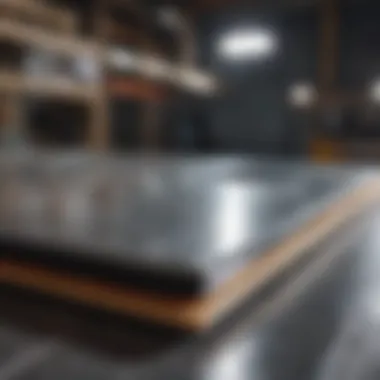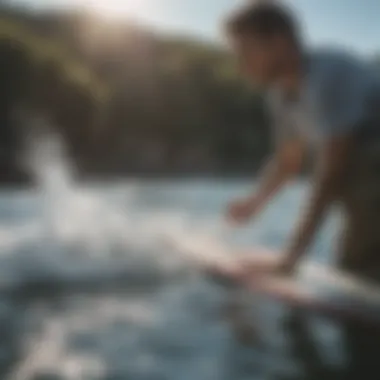Understanding Foil Boards: Mechanics and Innovations


Intro
Foil boards have taken the kiteboarding world by storm in recent years. Their unique design allows riders to glide above the water surface, providing a smooth and exhilarating experience. Understanding how these boards work, the materials that make them, and their potential applications is crucial for any enthusiast who wants to elevate their skills.
The Allure of Foil Boards
The excitement around foil boards doesn't just stem from their sleek appearance. They offer a new way to engage with the wind and water, creating opportunities for riders to explore and push boundaries. It's a blend of kinetic energy and physics that captivates both seasoned kiteboarders and curious newcomers.
"Foil boards redefine the relationship between kiteboarding and the ocean, offering a ride that combines speed and serenity."
Kiteboarding isn't just a sport; it’s a lifestyle, brimming with adventure. In diving into the mechanics and innovations surrounding foil boards, we aim to provide a lens through which you can appreciate the nuances of your ride.
Gear Insights
To get the most out of kiteboarding, having the right gear is essential. The varied landscapes and conditions call for boards tailored to specific needs. Let's break it down.
Latest Gear Reviews
When venturing into the world of foil boards, some stand out due to their performance and craftsmanship. Here are a couple to consider:
- Slingshot 2022 Ghost Whisper: Known for its lightweight construction yet sturdy feel, this board offers fantastic stability even in choppy waters.
- Cabrinha Xcaliber: This surf board makes transitioning to foil boarding easier. Its sharp edges cut effortlessly, carving out turns with precision.
When selecting gear, consider not just performance but also durability and ease of use. Research choices that suit your personal style, and read reviews from fellow riders to inform your decision.
Essential Gear for Beginners
For those just starting with foil boarding, a few key items make a world of difference:
- Foil Board: An entry-level board that balances stability with ease of use is crucial.
- Kite: A medium-sized kite works best; it provides lift without overwhelming beginners.
- Harness: A comfortable harness ensures you can ride longer without fatigue.
Start simple. Mastering the basics initially allows you to build confidence and skills. Over time, you will discover what works best for your style.
Techniques and Tips
When it comes to kiteboarding, mastering the craft involves more than just the right gear. Techniques and safety practices are foundational.
Advanced Tricks and Techniques
Once you’ve gained some experience, consider integrating these techniques into your routine:
- Jumping: Start with small hops; focus on timing your kite pull.
- Transitions: Practice shifting from toe to heel edge seamlessly.
- Riding Switch: Challenge yourself by riding in the opposite stance for added skill.
Practice these tips consistently, and you'll soon find your performance elevating to new heights.
Safety Practices for Kiteboarders
Safety cannot be overlooked in a sport where the elements play a significant role. Here's what every kiteboarder should keep in mind:
- Know the Weather: Be aware of wind patterns, tides, and potential changes.
- Wear a Helmet: Protect your head; this shouldn't be optional.
- Stay Aware: Keep an eye on other riders and obstacles in the water.
Remember, the key to enjoying kiteboarding is maintaining safety while having fun. The thrill of riding a foil board should never come at the cost of caution.
Through a careful understanding of gear, techniques, and safety, kiteboarding can be a rewarding experience. Strive to hone your skills and stay updated on the latest innovations in foil board technology.
Prologue to Foil Boards
Foil boards have burst onto the scene in the watersport community, stirring up curiosity and enthusiasm among kiteboarders and adventurers alike. Understanding the nuances of these boards is crucial, as they mark a significant evolution in how we engage with water. By lifting above the surface, foil boards redefine speed, maneuverability, and the overall experience on the water. This article intends to unpack the complex mechanics behind foil boards, alongside their various applications and the innovative designs shaping their future.
Definition and Purpose
To get our feet wet, let’s define what a foil board really is. At its core, a foil board consists of a platform that’s attached to an underwater wing, or foil. When a rider gains speed, the foil generates lift, allowing the board to glide above the water. This lift decreases drag, allowing for smoother navigation, even on choppy waters. Think of it like soaring through the air; the sensation is unlike anything else in water sports.
The purpose of foil boards extends beyond just riding the waves. They reshape the very way we think about buoyancy and propulsion in recreational sports. Possessing this lifting capability allows users to explore different terrains, heights, and speeds previously unthinkable with traditional boards. Additionally, their ease of use in lighter winds makes them particularly appealing to seasoned riders and newcomers alike.
Historical Context
Foil boards weren’t conjured up overnight; they have a lineage that draws from various water sport inventions. The innovative spirit can be traced back to the early 1960s, when hydrofoil sailing boats first appeared. These boats were designed to raise above the water to reduce drag. Fast forward to the 1990s, and kite surfing enthusiasts began to experiment with similar principles.
The dawn of modern foil boarding emerged in the late 2000s, as specialized designs for kiteboards took root. Enthusiasts started crafting custom foils, blending materials and shapes to achieve better performance. It brought a fresh perspective to kiteboarding, enabling riders to harness lighter winds. Today, competitive leagues showcase the incredible versatility and agility of foil boards, establishing them as essential gear in the sport.


"Understanding the journey of foil boards helps to appreciate the dynamic nature of water sports and the relentless pursuit of innovation."
Thus, the foundation of foil boarding is layered in both engineering advancements and the human desire to explore new frontiers on the water.
Components of a Foil Board
The functionality of foil boards is intricately tied to their components, each playing a vital role in performance and rider experience. Understanding these components will help both seasoned kiteboarders and novices alike to make informed decisions and enhance their time on the water.
Board Structure
Foil boards come in various shapes and sizes, but their structure fundamentally consists of a sturdy core and a surface designed for balance and agility.
- Core Material: Generally made of lightweight materials such as EPS foam or carbon fiber, the core is what gives the board its buoyancy. Lightweight yet strong materials are essential for achieving high-speed maneuvers without losing stability.
- Surface Design: The upper surface of the board often comes with non-slip textures that ensure riders have a firm grip during intense rides. Texture and hull design not only assist in grip but also optimize hydrodynamics. This can greatly affect how efficiently the board glides through water.
A well-thought-out structure ensures that riders can maintain balance while maneuvering through waves, making it a cornerstone for performance.
Foil Mechanics
Understanding how foils work can unlock endless potential for any kiteboarder. The foil itself consists of a mast, wings, and fuselage, and each part plays a crucial part in lift generation.
- Mast: This is the vertical piece that connects the board to the foil. The height of the mast can dramatically change a rider's experience. Shorter masts tend to be more stable but offer less height, while longer masts allow for increased lift but may require more skill to control.
- Wings: The shape and size of the wings are all important in generating lift. Larger wings are generally better for slower speeds and beginners, offering a more stable ride. Conversely, smaller wings are preferred by advanced riders for high-speed performance.
- Fuselage: Connecting the mast and wings, the fuselage influences the stability and handling of the foil. The choice of fuselage can affect the board's overall responsiveness and how well it cuts through water. A well-designed fuselage creates a smoother ride, reducing turbulence.
Material Considerations
When it comes to materials, the choices can greatly impact performance and durability. It's no secret that innovative materials offer various advantages whether it's for the board or the foil components.
- Fiberglass vs Carbon Fiber: Fiberglass foils are typically more affordable and provide decent performance but often fall short when it comes to flexibility and weight. On the other hand, carbon fiber, while pricier, delivers superior strength-to-weight ratios, allowing for faster speeds and improved maneuverability.
- Resins: The types of resin used in the construction can also affect weight and durability. Epoxy resins, for instance, provide both weight savings and better impact resistance compared to traditional polyester resins.
The interplay of these materials affects everything from weight distribution to strength, making it an essential topic for those diving into the world of foil boarding.
"The key to effective riding isn’t just practice on the water; it starts with understanding what you ride on."
In summary, the components of foil boards are not to be underestimated. The board structure, foil mechanics, and material choices all intertwine to elevate the kiteboarding experience. By paying attention to these details, riders can tweak their gear to better fit their personal riding style, ultimately enhancing performance.
How Foil Boards Function
Understanding how foil boards function is essencial for anyone looking to harness their potential in kiteboarding. Foil boards employ a unique design that elevates the rider above the water, enabling a smoother ride and access to different conditions that would be challenging for traditional boards. At the heart of their operation are two key aspects: lift generation and balance and control. Each of these components plays a crucial role in determining the performance and usability of foil boards.
Lift Generation Physics
The lift generated by a foil board is rooted in basic principles of physics. When a foil board moves through the water, the design of the foil itself causes pressure differences that ultimately results in lift. To put it plainly, as the foil slices through the water, it forces the liquid around it to move, creating an area of lower pressure above the foil while maintaining higher pressure below. This difference in pressure causes the foil to rise, bringing the board—and the rider—above the surface.
- The angle of attack of the foil is quite critical here. Too steep, and the foil might stall; too shallow, and it won't generate sufficient lift.
- Additionally, the speed of the board contributes to lift. The faster the board travels, the more lift is created until the balance point is reached.
- Generally speaking, kiteboarders often aim for a speed that optimizes lift while maintaining control.
Utilizing lift effectively transforms the riding experience. When executed properly, riders can glide over choppy waters with ease, feel less drag, and achieve better speeds. This lead to improved overall performance compared to traditional riding methods. Understanding these physics concepts is useful not just for performance but also for enhancing safety on the water.
Balance and Control
Once the lift is generated, maintaining balance and control becomes paramount. Unlike surfing or traditional kiteboarding, where the board is mostly in contact with the water, a foil board's operation requires constant adjustments in body position and weight distribution. Achieving balance may seem tricky at first, but over time, riders learn to gauge the subtle movements necessary to stabilize their ride.
Some key factors impacting balance and control include:
- Weight Distribution: Shifting weight forward or backward on the board can dramatically alter lift and stability.
- Foot Placement: Proper foot positioning aids in controlling the direction of the board and adjusting to various wave conditions.
- Body Alignment: Keeping the body aligned with the foil helps in maintaining stability. Rushing movements can easily lead to a loss of control, especially at high speeds.
"The key to foil boarding isn't just in riding the lift; it's about mastering the dance of balance that unlocks the thrill of the experience."
Riders must also be aware of their environment. Wind conditions, water surfaces, and the presence of other surfers can all affect how one should navigate with a foil board. Adapting to these variables demands not just skill but also a subtle understanding of how the board functions under different circumstances. By practicing balance and refining control techniques, riders can enhance their proficiency, making their participation in kiteboarding both exciting and fulfilling.
Applications of Foil Boards
The applications of foil boards extend beyond simple leisure activities, weaving into various realms of water sport. A keen understanding of how these boards are utilized in different settings amplifies their relevance to both enthusiasts and manufacturers alike. Foil boards elevate the experience of riding the waves, letting users glide effortlessly above the water surface while tapping into the natural forces of wind and waves. Such versatility brings distinct advantages and considerations into play, making it essential to examine these elements closely.
Kiteboarding Uses
Kiteboarding is perhaps the most recognized sport where foil boards shine. With the unique design that allows for lifting out of the water, foil boards significantly enhance performance for kiteboarders. Riders experience increased speed and maneuverability, particularly in lighter winds, making it possible to glide smoothly even when the wind conditions are less than ideal.
The sensation of flying above the water is like no other, and kiteboarders often describe it as a transcendent experience. This capability to ride with minimal drag not only boosts efficiency but also allows for longer sessions on the water. It does take a bit to get the hang of controlling the balance while soaring above the waves. Most riders would agree, the learning curve can feel steep at first, but the reward is worth it.
Additionally, kiteboarding on foil boards opens up places that traditional boards cannot—shallow waters or locations with less wave height, for instance. Kiteboarding has evolved rapidly, and the latest innovations in foil design allow for greater customization, catering to different riding styles. This adaptability makes the sport appealing to a broader range of users, from beginners to seasoned pros.


Other Water Sports
Aside from kiteboarding, foil boards have carved a niche in other water sports as well. Stand-up paddleboarding (SUP) and surfing have both seen an influx of enthusiasts adopting foil technology. In the realm of SUP, users can enjoy the thrill of riding swells at reduced effort. The ease of gliding allows for more casual and longer tours on flat waters. Some paddlers have even begun to incorporate tricks, riding in a manner reminiscent of skateboarding.
When it comes to surfing, foils add a new dimension to the experience. Surfers can ride smaller waves that might not have been feasible with traditional surfboards. The ability to catch more waves translates to increased fun and versatility for the surfer. The technology is transitioning the sport, leading to a growing branch known as foil surfing, where maneuverability and speed take center stage.
It's essential to note that while the potential is vast, the integration of foil boards into other water sports raises some challenges as well. To accurately navigate different conditions, the specific skill set required can differ considerably from traditional methods. Riders need to adapt to the unique responses of foil boards under varied water and wind conditions, which means not only honing their physical abilities but also understanding the nuances of their equipment.
"The beauty of foil boards lies in their versatility across the diverse spectrum of water sports, allowing riders to explore new experiences and expand their skills like never before."
Ultimately, these applications represent an exciting frontier for adventurous souls. Whether one is drawn to the kiteboarding rush or the smooth glides of paddleboarding, foil boards are changing the landscape of water sports, inviting new enthusiasts into the fold and challenging existing riders to broaden their horizons.
Advantages of Using Foil Boards
Foil boards have gained significant traction among water sports enthusiasts, especially within the kiteboarding community. In this section, we will explore the various advantages that make foil boards not just a trend but a true game-changer for many riders. Understanding the perks can help both novice and seasoned kiteboarders make informed choices in gear selection. Let’s delve into three main benefits – enhanced performance, reduced drag, and versatility in varying conditions.
Enhanced Performance
Foil boards are specifically engineered to elevate performance, pushing the boundaries of what's achievable on the water. When you ride a foil board, you're not merely skimming the surface; instead, you're gliding smoothly just above it. This sensation results from the lift generated by the hydrofoil, which effectively reduces the effects of choppy water and wind resistance. Riders experience faster speeds and sharper turns, allowing them to navigate through larger swells and challenging environments with greater control.
One major point here is the weight of the board. Many foil boards are lighter than traditional kiteboards. This weight reduction plays a pivotal role in performance. Riders can execute tricks and maneuvers with a finesse that’s difficult to achieve on heavier boards. In essence, if performance is what you’re after, experimenting with a foil board can provide that extra edge.
Reduced Drag
One of the standout features of foil boards is their ability to minimize drag significantly. Unlike conventional boards, where the entire surface is in contact with the water, a foil board functions with only its hydrofoil submerged. This design effectively reduces the resistance faced when moving through water, which translates to improved ride quality. The result is that riders can maintain higher speeds with less effort, making longer sessions much more enjoyable.
"The less drag you encounter, the more energy you save for doing what you truly love on the water."
Reducing drag doesn't just mean quicker rides; it also means energy efficiency. For those who find themselves feeling fatigued after shorter sessions, switching to a foil board may be the solution. With reduced water resistance, riders can cover significant distances with less exertion, leaving more stamina for exploration and fun.
Versatility in Conditions
A point worth mentioning is the adaptability of foil boards across a range of conditions. Rising tides, variable winds, or choppy waters are often seen as obstacles for traditional kiteboard setups. However, foil boards excel precisely in these tricky situations. Whether it’s light winds or rough water, a foil board's design allows for effective performance. The lift generated helps riders take advantage of even the gentlest breeze, opening doors to kiteboarding in conditions that once seemed unsuitable.
Also, the adjustments made to the foil configuration can fine-tune rides. Many riders can modify their boards according to the activity at hand—whether that’s foil surfing in small waves or wind-powered exploration over flat water. The flexibility in usage makes foil boards a worthy investment for anyone serious about water sports.
In summary, the advantages of using foil boards extend beyond mere performance enhancements. They offer reduced drag that leads to greater efficiency, and they thrive in a variety of conditions, thus appealing to a wide range of riders. As these benefits become more recognized, it’s clear that foil boards are not just innovative tools but essential gear for modern kiteboarding adventures.
Challenges and Limitations
Exploring the realm of foil boards is akin to unveiling a double-edged sword. While the exhilarating feeling of gliding effortlessly above water is tempting for many adventurers, it's equally crucial to recognize the challenges that accompany this advanced piece of equipment. Understanding these challenges and limitations can provide enthusiasts with a substantial perspective, helping them to navigate their learning journey more effectively.
Steep Learning Curve
Learning to master a foil board is not a stroll in the park. Many newcomers often feel as if they're grappling with a whole new dimension of kiteboarding. The steep learning curve can be daunting; one day you're content riding on traditional boards, and the next, you find yourself atop a foil board, trying to find your balance.
This balance is not just about body positioning but also about understanding the nuances of lift and drag. Newbies can expect to wipe out more often than not, catching more water than air as they learn the ropes.
- Physical Coordination: Mastering the board requires significant physical coordination. Riders must synchronize their movements to maintain stability while controlling speed.
- Understanding Wind Dynamics: The speed and direction of the wind affect a foil board's performance significantly. A rider must adjust to these changing dynamic conditions– a decisive factor that takes time to comprehend and perfect.
Many kiteboarders, after a few tumultuous sessions, might feel tempted to hang up their boards for good. However, perseverance is key. Gradually, with practice and adaptability, they begin to grasp the essential techniques needed to ride smoothly and confidently. Ultimately, success on a foil board often leads to that unprecedented thrill of flying above the water, making the struggle worthwhile.
Cost Considerations
Setting your sights on foil boarding often means a hefty financial commitment. The gear involved, from the board itself to the accompanying kite and bar, can turn into a sizable investment.
- Initial Investment: When starting out, the upfront cost can be quite intimidating. For instance, a decent quality foil board can range from several hundred to a few thousand dollars. On top of that, adding the cost of a kite and other essential gear can make many newcomers feel as if they’re sailing into an expensive adventure.
- Maintenance Expenses: Beyond the initial purchase, gear maintenance is an ongoing expense that should not be overlooked. Scratches, dings, and general wear can occur from repeated use. Repairing these damages or purchasing replacements can pile up quickly.
- Skill Progression: As riders improve, they may find they’re looking to upgrade their gear periodically. What was once a perfect fit for an amateur may soon become inadequate for a seasoned rider, leading to an additional investment cycle.
While the costs associated with foil boarding can seem formidable, it's essential to view these expenses in a broader context: as a means to gain unique experiences and skills. Riders often justify their investments by reflecting on the unparalleled joy and satisfaction they derive from mastering the art of foil boarding.
"The thrill of riding above water, feeling the wind in your face, is worth every penny spent on learning and gear."
Embracing the challenges and limitations involved with foil boards can ultimately enrich the experience for kiteboarders, transforming initial setbacks into steppingstones for success.
Selecting the Right Foil Board
Choosing the right foil board is crucial for both newcomers and seasoned riders in the world of kiteboarding. The right board can elevate your performance, enhance your enjoyment, and even prevent potential mishaps on the water. It's not just a matter of picking the first shiny model you see; it's about understanding how different features affect your riding experience. The decisions you make today will influence your time on the water and your long-term satisfaction with the sport.
Factors to Consider
When selecting a foil board, several factors must be taken into account to ensure a match between your riding style, skill level, and environmental conditions.


- Skill Level: Beginners might want a larger board that offers stability and ease of use. In contrast, more experienced riders may seek a smaller, more agile board for tricks and speed.
- Board Size: Size affects buoyancy and lift. Longer boards can provide more stability, while shorter boards result in quicker turns and maneuverability.
- Weight Capacity: Your board should support your weight adequately. Boards come with different weight ratings, so knowing your size is key.
- Foil Type: The design of the foil itself makes a difference. Higher aspect foil wings can give you greater speed and are usually favored by skilled riders, but they are less forgiving when it comes to errors.
- Material: Boards are made from various materials, including foam, fiberglass, and carbon fiber. Each material has its pros and cons in terms of durability, weight, and cost.
- Fin Configuration: Boards can come with different fin setups which can affect your stability and tracking in the water.
"Selecting the right foil board is akin to picking the right shoe for a long trek; comfort and compatibility make all the difference."
Brands and Models Overview
With a myriad of brands and models on the market, it can be bewildering to make a choice. Here’s a quick overview of some respected names within the community.
- Slingshot: Known for their high-quality designs suited for both beginners and experts. Their boards are often praised for stability and performance.
- Naish: Offers a variety of boards tailored to different riding styles. Their products are durable and known for excellent tracking.
- Ozone: A trusted brand that has engineered great performance boards, especially for experienced riders who want speed and agility.
- Fanatic: Known for their eco-friendly materials and solid construction, making them a favorite for environmentally-conscious kiteboarders.
- Duotone: A competitive brand in the kiteboarding scene, known for their innovative designs that meet both performance and aesthetic standards.
Keep an eye on the latest offerings as innovation in design and technology continues to evolve the kiteboarding landscape.
Making the right choice when selecting a foil board involves thoughtful consideration of these factors. Equip yourself with knowledge and don’t rush the decision-making process. Enjoying the ride begins with ensuring your equipment meets your needs.
Maintenance of Foil Boards
Proper maintenance of foil boards is crucial not only to enhance their lifespan but also to ensure they perform at their best during each session on the water. When you invest in a foil board, whether it’s for kiteboarding or any other water sport, neglecting its upkeep can diminish both performance and safety over time. This section will delve into practical maintenance tips and common repair techniques.
Routine Care Tips
Keeping your foil board in top-notch shape doesn’t require excessive effort; rather, a few simple habits can make all the difference. Here are some tips to maintain your foil board effectively:
- Rinse After Use: Always rinse your board with fresh water after riding in saltwater. This helps prevent corrosion and buildup of salt deposits that can eat away at the materials.
- Check for Wear and Tear: Regularly inspect the board for any signs of scratches, dents, or other damages. Addressing these issues early can prevent larger problems down the line.
- Store Properly: When it's time to stow your gear, avoid leaving the foil board exposed to direct sunlight for prolonged periods. Instead, keep it in a cool, shaded area to protect it from UV damage, or wrap it in a bag for added protection.
- Foil Cleaning: The foil itself can accumulate dirt and grime. Use a soft cloth and mild soap to clean it gently. Avoid abrasive cleaners, as these can scratch the surface.
- Tightness Check: Regularly check that all screws and fittings are tightened, particularly those holding the foil to the board. Loose fittings can compromise both performance and safety.
Damage Repair Techniques
Despite the best of care, accidents do happen. Knowing how to address damage can save you time and money while keeping your board in the best possible condition. Here are some fundamental repair techniques:
- Minor Scratches: For light surface scratches, a fine-grit sandpaper can be used to smooth out the area. Sand gently and then polish the surface with a polishing compound suitable for the material of your board.
- Dents: If the board has a small dent, you can often repair it by applying gentle upward pressure from behind, perhaps using a towel or soft pad to avoid further damage. This can pop the dent back into shape, but make sure not to apply excessive force.
- Delaminations: If you notice that the board's layers are separating, apply a suitable marine adhesive according to the manufacturer’s instructions. Ensure the area is clean before applying the adhesive, and clamp the area until it dries. This type of repair may require additional skill and tools, and it might be worthwhile to consult a professional if you are uncertain.
- Foil Shaft Repairs: For damages involving the foil shaft, it's often best to replace it entirely, as attempting to weld or reinforce could lead to structural failures while you're out riding.
Keeping a well-maintained foil board not only improves your performance but can also be the difference between a fun ride and a frustrating experience. A little effort in maintenance goes a long way.
By fostering these routines and understanding basic repairs, you can greatly enhance the durability and enjoyment of your foil board, keeping it ready for the next adventure on the waves.
Current Trends in Foil Board Design
The design of foil boards is continually evolving, showcasing the industry’s response to a blend of performance needs and environmental consciousness. Recognizing current trends is essential for both enthusiasts and professionals alike, as it can heavily influence not only purchasing decisions but also riding experiences. These trends represent the forefront of innovation in the foil board realm, offering significant benefits such as improved performance, enhanced durability, and a commitment to sustainability.
Technological Advancements
Recent years have ushered in a wave of technological advancements that have dramatically altered the landscape of foil board design. These innovations have enabled riders to experience enhanced performance and adaptability on the water.
- Smart Materials: The introduction of smart materials has caught the attention of many manufacturers. These materials react dynamically to changes in water conditions, offering riders better control. For example, a board embedded with sensors can provide real-time feedback on speed and stability, allowing for quick adjustments.
- Shape Optimization: Advances in hydrodynamics have also led to better shape optimization of foil boards. Designs are more refined than ever, focusing on the contours that reduce drag and maximize lift. Wind channel testing has become a key process in shaping these boards—an approach that can lead to unexpected innovations in form.
"Through continual iteration, boards are not just products; they are reflections of our evolving understanding of hydrodynamics."
- Modular Systems: Modular designs have also gained popularity, allowing users to customize their boards without needing to purchase an entirely new setup. Riders can swap out foils or adjust their configurations to suit specific conditions or personal preferences, tailoring the experience to fit their needs.
Embracing these advancements does not merely enhance performance; it fundamentally reshapes how riders interact with their environment. The tide is turning toward technology-driven designs, and those who keep their ear to the ground will find the best options available.
Eco-friendly Materials
The foil board industry is witnessing a notable shift toward eco-friendly materials. As environmental consciousness grows, manufacturers are responding with sustainable practices and materials that have less impact on the planet. This trend is not merely a marketing gimmick; it's becoming a significant factor in the decision-making process for many consumers.
- Recycled Components: Many brands are incorporating recycled plastics and organic composites into their boards. These materials maintain high performance while reducing waste, bridging the gap between quality and sustainability. For example, recycled PET is becoming a popular choice, offering strength without the environmental toll.
- Bio-based resins: The use of bio-based resins is another promising trend. These resins, derived from natural plants, significantly reduce reliance on petroleum-based products. This not only minimizes the carbon footprint but enhances the biodegradability of the boards after their life cycle ends.
- Sustainable Production Practices: Even the production processes are under scrutiny. Companies now prioritize low-impact manufacturing that decreases water consumption, emissions, and energy usage. Brands that adopt these practices not only appeal to eco-conscious consumers but also promote a larger movement toward sustainability in outdoor sports.
As kiteboarders increasingly seek products that align with their values, staying informed about these eco-friendly advancements is crucial for making responsible choices. The dual commitment to high-performance and sustainability is reshaping the offerings in the foil board market, carving a path for future innovations that prioritize our ecological footprint.
Epilogue
In this article, we’ve dissected the multiple layers of understanding foil boards, focusing on their mechanics, applications, and innovations. A good grasp of this knowledge is crucial, not just for enthusiasts but also for those who are teaching or guiding novices. It’s easy to fall in a rut thinking that enjoying a sport is only about the thrill, but the more one digs into the technical aspects, the more refined the experience becomes.
Considering the complexity of lift generation and balance, one might argue that knowledge of foil boards leads to greater performance on the water. Understanding how these boards function can make a kiteboarder more adaptable, especially when faced with variable conditions. Identifying the right board and recognizing its strengths allows users to customize their experience, ultimately making water sports more enjoyable.
Summary of Key Points
- Definition and Purpose: Foil boards offer a unique riding experience that enhances performance through lift.
- Components: Understanding the board structure and foil mechanics is key.
- Applications: They find usage not just in kiteboarding but across multiple water sports.
- Advantages: The reduced drag and versatility mean these boards can shine in various settings.
- Challenges: Beginners face a steep learning curve, along with financial considerations in acquiring quality gear.
- Maintenance: Regular care and repair knowledge can significantly increase the longevity of these boards.
- Current Trends: Keeping an eye on technological advancements and eco-friendly materials can influence future picks.
The importance of these points cannot be overstated. They pave the way for a more informed community of riders who can fully appreciate and maximize the capabilities of their gear without compromising performance or safety.
Future Outlook
The future of foil boards is an exciting terrain to navigate. Innovations in materials and construction methods will likely lead to lighter, stronger boards that can withstand harsher conditions. Several manufacturers are actively pivoting towards eco-friendly materials, which could reshape the landscape in sustainable water sports.
Also, brand engagement is headed into the digital realm, with communities forming on platforms like Reddit and insights being shared on Facebook. As enthusiasts and professionals band together to share their experiences, the collective knowledge will no doubt support further innovations.
As this niche sport grows, we can expect advancements in tech that not only enhance the riding experience but also cater to customizability. Tailoring gear to suit individual needs will become much more accessible, ultimately allowing kiteboarders from all walks of life to ride to their fullest potential. Whether it’s adding smart technology or finding better ways to maintain boards, the future is bright for foil board aficionados.















